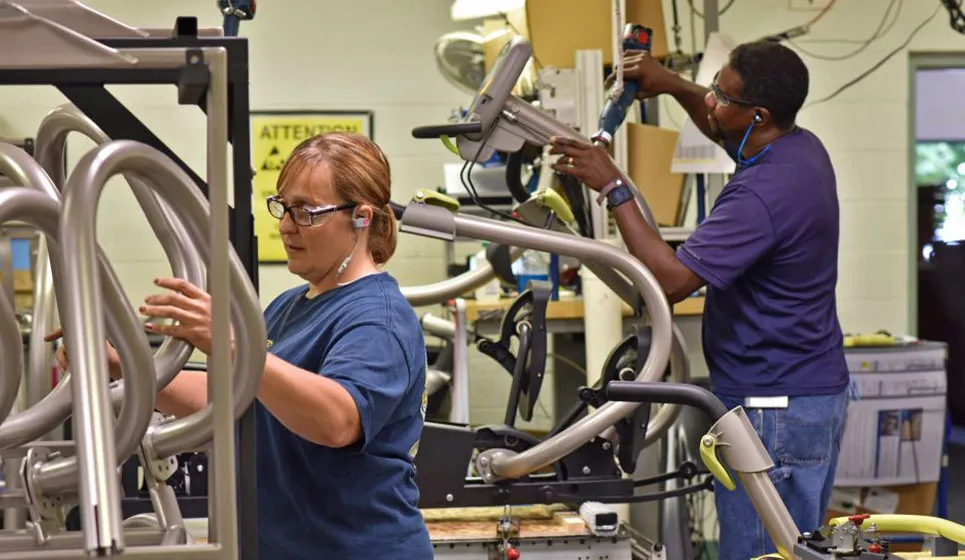Operations and Safety don’t always speak the same language, not because Operations isn’t committed to keeping people safe at work or Safety isn’t concerned with meeting operational goals, but rather because each area has its own methods, processes, and measures. This communication gap can increase when ergonomics is added to the mix. Ergonomics is often part of the Environmental, Health, and Safety (EHS) function, but ergonomics differs from other areas of EHS. In many cases, EHS is focused on unlikely events with severe or even catastrophic outcomes. As a result, EHS typically has regulations and standards that must be met to mitigate these hazards.
The High Cost of Musculoskeletal Disorders
According to the Bureau of Labor Statistics (BLS), musculoskeletal disorders (MSDs) account for one-third of all occupational injuries and illnesses in the US across all sectors, including manufacturing. These injuries and illnesses carry significant direct and indirect costs (including workers’ compensation costs) and are often preventable using ergonomics. While these MSDs can be expensive and seriously impact the individual, they are not as catastrophic as incidents that can occur in other areas of EHS. And unlike those other areas of EHS, ergonomics has relatively few standards or regulations. In place of regulations, ergonomics generally relies on a continuous improvement process that aims to reduce workplace risk exposure. For those who may still be learning the language of safety, this departure from a standards-based decision-making process can seem strange.
How Can You Build Support for an Effective Ergonomics Process?
To help build stakeholder support for an effective ergonomics process, present the goals and process in language that is more familiar to operations. When presenting the goals, don’t minimize the safety impact of ergonomics. Operations wants people to have a safe place to work. But be clear that improved safety is not the only benefit derived from ergonomics. Research has shown that fitting jobs to human capabilities removes barriers to performance and thereby improves quality and productivity.
It can also help to express the ergonomics process in the terminology of another process with which most in Operations are familiar: lean. Lean improves operational performance by reducing waste. Ergonomics improves safety performance by reducing the risk factors associated with MSDs. A successful ergonomics process approaches risk in the same way that a lean process approaches waste. Both approaches use a continuous improvement model, such as Six Sigma or Plan-Do-Check-Act (PDCA), to change the work environment. For example, some of the typical steps that an organization takes to implement a lean process include the following:
- Appoint a manager or process lead
- Establish a core team
- Provide skills training for the team and awareness training throughout the organization
- Engage in the continuous improvement cycle:
- Review data to prioritize efforts
- Conduct detailed analyses to quantify the problem and identify underlying causes
- Implement countermeasures
- Evaluate the effectiveness of countermeasures
- Report progress to management
- Repeat improvement cycle
- Evaluate/audit the process
- Modify the process as necessary to enhance effectiveness
These are the same steps that an effective ergonomics process follows to reduce the risks associated with MSDs and to ultimately protect employee health and safety. Ergonomics, like lean, is an ongoing process designed for steady improvement, not a “one-and-done” program.
Key Takeaways About Introducing Ergonomics to Operations
Ergonomics takes time to implement, but it also shows employees that their employers care about their well-being. This is not the same perception often conveyed to a worker just by “creating a safe work environment.” Anyone can create a safe work environment. It’s more challenging to add workers’ physical well-being into consideration. Ergonomics takes that into account while also serving the employer’s end goals of productivity and quality.
Of course, doing ergonomics right is easier when you have better tools. Look into the benefits of modern ergonomics software, but make sure you’re not just getting any software. The best software enables you to conduct 3-D motion capture of employees as they perform tasks, with built-in intelligence to help you accurately assess MSD risks, determine root causes and select appropriate controls.
Let VelocityEHS Help!
VelocityEHS is just the partner you’re looking for to improve your ergonomics processes and integrate them with operations. Our powerful AI-driven SaaS global enterprise ergonomics solutions deliver continuous improvement and are backed by the industry’s largest team of board-certified ergonomists.
We understand that it’s not just doing ergonomics assessments that matters; it’s using the assessments to improve workplace safety. That’s why the 3D Model for Motion Capture in our VelocityEHS industrial ergonomics software provides the most comprehensive MSD risk assessment available, incorporating automatic scoring of wrist bending and back twisting, and even capturing data from hidden body segments. You’ll also be able to conduct assessments from anywhere using a mobile device, and then rely on powerful AI capabilities that help you identify risks and root causes and select better controls from expert-curated drop-down menus, so you can put your assessments to their intended use. You’ll have greater confidence in your assessments and overall ergonomics process.
And those are just some of the ways we can support you. Contact us today to learn more about how we can help you improve worker health and productivity.
